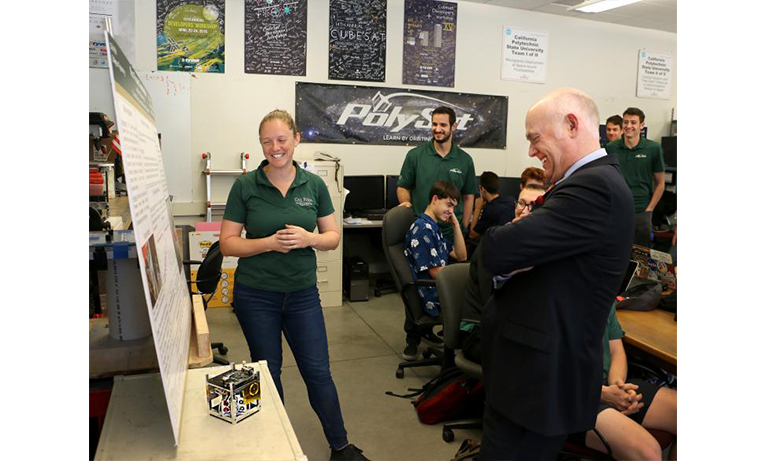When students gather at the University Union to watch a historic Mars landing Monday, members of the PolySat team will be there to boast about their own space exploration.
The team will have a booth at the University Union, (room 220, 11 a.m.) during a live broadcast from NASA featuring the landing of InSight. The robotic lander represents the first mission to study the deep interior of Mars – its crust, mantle and core. The broadcast will feature live commentary from NASA’s mission control at the Jet Propulsion Laboratory in Pasadena and live animations of InSight’s landing.
As NASA details its latest space coup, members of the PolySat team will be on hand to talk about its CubeSat named DAVE (Damping and Vibrations Experiment), which was launched into space Sept. 15. The mini-satellite tests a way to reduce vibrations aboard orbiting satellites, and the visuals it has provided offer stunning glimpses of the earth from space.

This artist rendition depicts NASA’s InSight lander over Mars. InSight is set to land on the Red Planet Monday.
The PolySat team has posted several photos on its Facebook page, and it just released its first high-resolution image, depicting Svalbard, the Norwegian archipelago located between Norway and the North Pole.
“This is one of our better pictures,” said Grigory Heaton, a senior studying aerospace engineering and physics from Ramona, CA. “Our satellite is not controlled. It’s just spinning, so we have to get lucky with the pictures. This one, we were right overhead and got almost the entire archipelago.”
The camera lens was apparently damaged during launch. All the images have a dark splotch near the center, possibly the result of being struck by an outgassed particle on the satellite, said PolySat member Michael Fernandez, a physics junior from Glendale, CA.

Members of the PolySat team released their first high-resolution image taken from DAVE, its CubeSat that is currently in space. The image depicts Svalbard, the Norwegian archipelago located between Norway and the North Pole. (PolySat image)
DAVE was designed and built by Cal Poly students, working with Northrop Grumman Aerospace Systems, to study the behavior of particle dampers in microgravity conditions. In space-based applications, particle dampers could potentially serve as a device to eliminate jitter in orbital assemblies or other sensitive scientific equipment at a reduced cost compared to existing technologies.
This has been an exciting time for the PolySat team. Last week, Tory Bruno, a Cal Poly alumnus and CEO of United Launch Alliance (ULA), visited the team at the Cal Poly CubeSat Lab. ULA launched the rockets that sent both DAVE and InSight into space.
Two CubeSats that launched with InSight were tested at Cal Poly. Called MarCO, the two briefcase-sized satellites — 12 inches tall, 4 inches deep and 8 inches wide — arrived on campus last February. Over the next 17 days, engineers from Cal Poly and the NASA’s Jet Propulsion Laboratory in Pasadena assisted in inserting, or integrating, the satellites into the deployment boxes that would eject each CubeSat into space. Meanwhile, Cal Poly students spent nearly 15 hours wrapping the deployment boxes in protective gold aluminized Kapton tape.
MarCO will fly by Mars while InSight lands on the Red Planet.
Cal Poly alumnus Timothy Weise (Aero, ’94 BS; Aero ’97 MS), who works for NASA, is a deputy mission manager on the InSight project.


